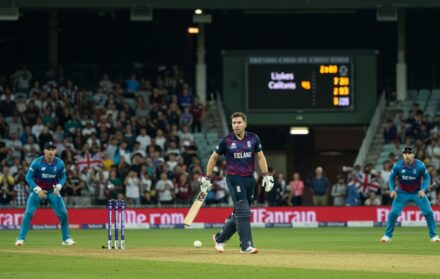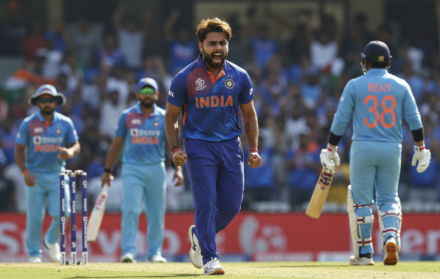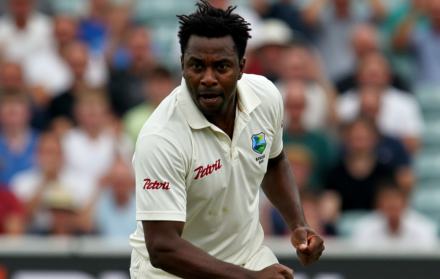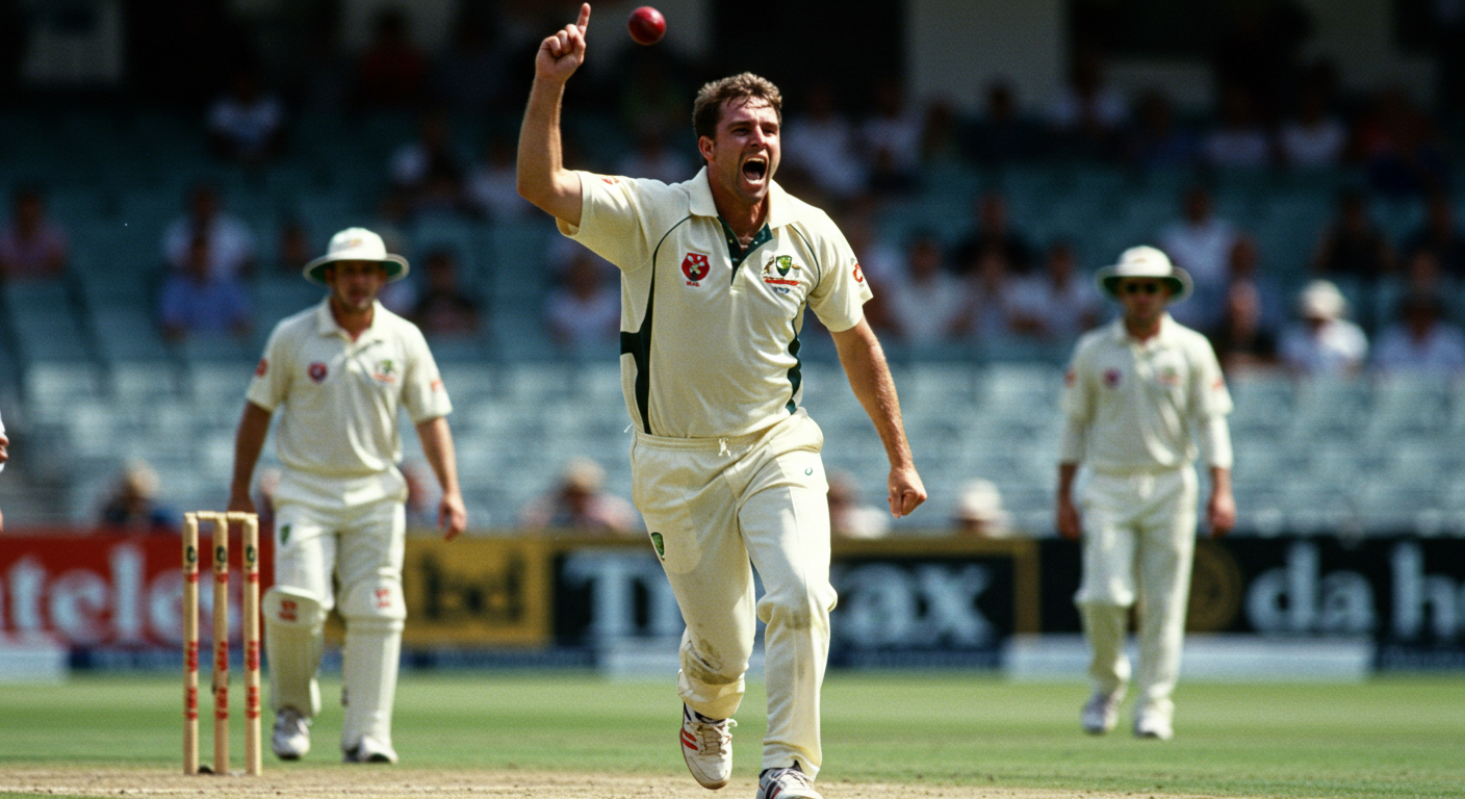
Glenn McGrath: The Metronome of Precision in Australian Cricket
In a team that boasted warlords of pace like Brett Lee and Mitchell Johnson, and artists of spin like Shane Warne, Glenn McGrath stood apart not by velocity or variation—but by control so relentless it broke batters mentally before it did physically. He was not intimidating by look or volume. There was no snarl, no glare. Just the same smooth approach, the same high release, and the ball landing on the seam at exactly the same length, over and over, until mistakes appeared like cracks in a dam.
McGrath didn’t need flair. He didn’t need theatre. His weapon was repetition—a tactical torment that forced the best players in the world to play outside themselves.
In an era of brash fast bowlers and short-pitched threats, McGrath was clinical—Australia’s cold blade in a golden generation of firepower. His numbers—563 Test wickets, 381 in ODIs—speak volumes, but they still don’t tell the full story. Because his greatest quality wasn’t found in the wicket column. It was in how he dictated matches before he even struck.
This article is not about speed. It’s about silence. About a bowler who turned control into chaos for his opponents. About the most machine-like destroyer the game has ever known.
The Line and Length That Ruined Careers
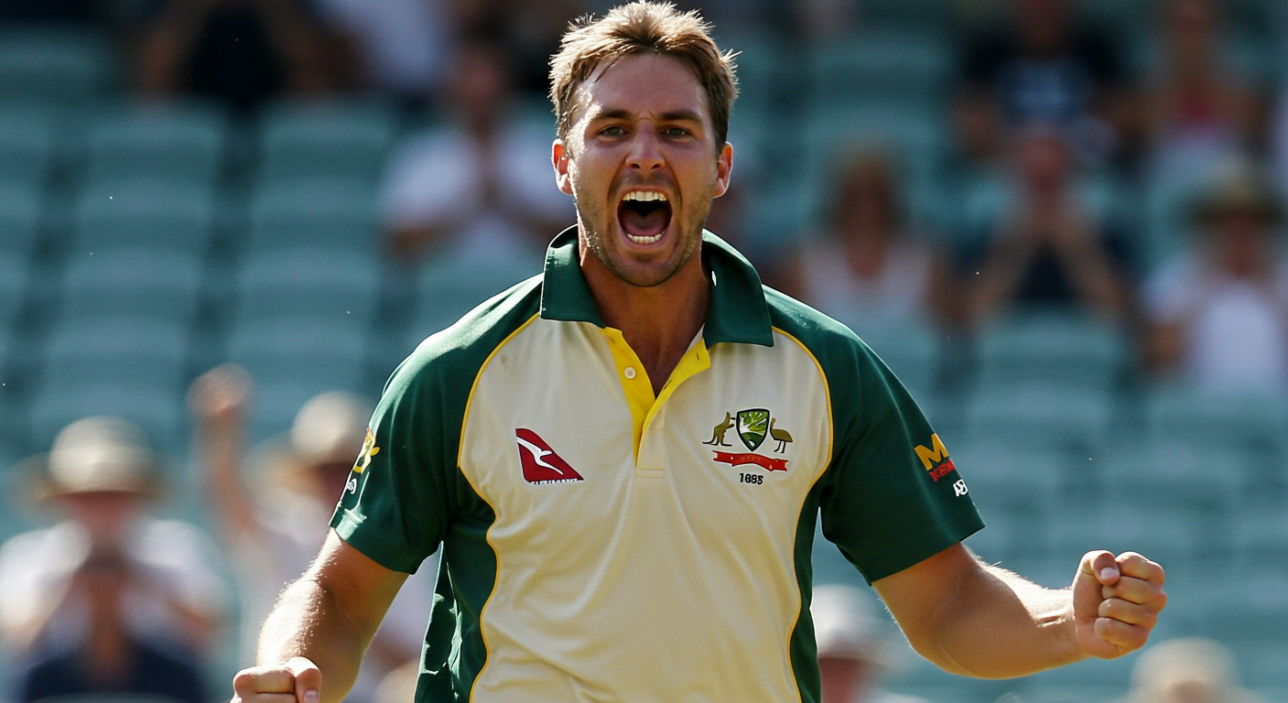
Glenn McGrath didn’t need tricks. His arsenal was built on discipline so exact it seemed unnatural, like the ball obeyed instructions no one else could give. He would land it on a corridor just outside off stump—six inches outside, on a good length—and leave it there until the batter broke.
The magic wasn’t that the delivery was unplayable. It was that it looked so playable… until it wasn’t. The movement off the seam was subtle, not extravagant. But it was enough. McGrath’s genius was to give the illusion of control to the batter, then quietly take it away.
Even the greats suffered. Brian Lara, Sachin Tendulkar, Jacques Kallis—all fell repeatedly to him. McGrath didn’t rely on swing, didn’t intimidate with bouncers. He just landed the ball like a hammer on a pressure point. His dismissals weren’t highlight-reel fodder. They were slow suffocations.
And he didn’t get bored. Ball after ball, spell after spell, session after session, he asked the same question with surgical patience. Very few had the temperament to resist for long. Fewer still could counterattack.
It was this psychological edge—this quiet erosion—that turned McGrath from a fast bowler into a phenomenon of control. He didn’t run through teams in a blaze. He eroded them, calmly and cleanly.
Big Match, Big Wickets, Small Fuss
Some players ride waves of momentum; others make their name in pressure moments. But Glenn McGrath wasn’t interested in noise. He didn’t need a showdown or a spat. He simply turned up in the biggest games and did exactly what he always did—unmoved, unhurried, unshakable. And yet, those were the matches where he was most dangerous.
Look at the 2005 Ashes, a series Australia ultimately lost. On the first morning of the first Test at Lord’s, England were buzzing—new era, attacking intent, aggressive declarations. McGrath took 5 for 2 in 31 deliveries and killed the dream within an hour. He made the ball do just enough, and he made the moment his. He wasn’t bouncing them out or bowling magic balls. He was, as ever, on the spot, and England blinked first.
He did it in World Cups too. Across four tournaments, McGrath took 71 wickets—more than any other bowler in the tournament’s history. And when the pressure reached boiling point, he never spilled over. In the 2003 final, with India riding high on momentum, McGrath removed Sachin Tendulkar in the opening over. No theatrics, no celebration—just a calm walk back to his mark, already planning the next wicket.
It wasn’t just his figures that made him irreplaceable. It was the way his spells shaped entire matches. Captains built plans around him. Warne operated in luxury because McGrath provided pressure from the other end. Brett Lee bowled express because McGrath had already made batters doubt their technique.
He was the structure that allowed chaos to flourish around him. In knockout matches, away series, and final days, he never changed. That was the point. McGrath didn’t lift himself for big games—he was always at the same level. It just happened that most others weren’t.
The Quiet Alpha of a Loud Team

Australia in the late 90s and early 2000s was not a subtle team. There was Warne’s swagger, Ponting’s fire, Gilchrist’s flash, Hayden’s muscle, Lee’s pace. They chirped, stared, and dominated. But in the middle of it all was McGrath—tall, expressionless, utterly unaffected by noise. He didn’t need to assert authority. He was authority.
He wasn’t above sledging, of course. But his was of a different tone. He’d tell you how he’d get you out—and then do exactly that. No theatre, no shock. Just execution. Ask Michael Atherton, who faced him 19 times in Tests and was dismissed on 19 of those occasions. McGrath didn’t rattle batters with bouncers. He rattled them with inevitability.
He played in a team of match-winners but stood apart in method. While others rode emotions, McGrath rode rhythm. He gave Australia stability—a guaranteed 20 overs of unrelenting pressure. His teammates admired him not just for wickets, but for his discipline. When things were tense, McGrath would keep it simple: pitch it there, again and again.
That’s what made him dangerous. Not unpredictability, but predictability so suffocating that even the best cracked under it.
In a team of entertainers, McGrath was the control room. And every great empire needs one.
Adaptation Without Compromise
There’s a myth in cricket that longevity requires reinvention—that to last, a player must change who they are. Glenn McGrath challenged that idea. He didn’t reinvent. He refined. Over 14 years in international cricket, he stayed true to the same method: high wrist, upright seam, fourth stump, top of off.
And yet, he wasn’t static. McGrath quietly adapted—not by adding flashy new skills, but by reading conditions with forensic precision. In Australia, he adjusted for bounce. In India, he bowled fuller and straighter. In England, he let the ball wobble on the seam and waited. But the core never changed. He didn’t chase swing or try to reverse the ball like others did. He trusted his basics more than most trusted their breakthroughs.
That’s what made his record across formats so staggering. In ODIs, where control is currency, he was a banker. Batsmen tried to line him up in the Powerplay, but few succeeded. Even in the death overs, where yorkers and slower balls dominate, McGrath stuck to a stubborn length—and still delivered. His white-ball economy rate was under 4.0 in an era when bats got bigger and boundaries got smaller.
He played until his body said no, not his skill. Even in his last year of Test cricket, he was Australia’s most reliable bowler in the 2006–07 Ashes whitewash. And when he stepped away, it wasn’t in decline. He left at the top—calmly, like everything else he did.
McGrath never needed reinvention, because perfection doesn’t go out of style.
The Final Spell and the Standing Ovation
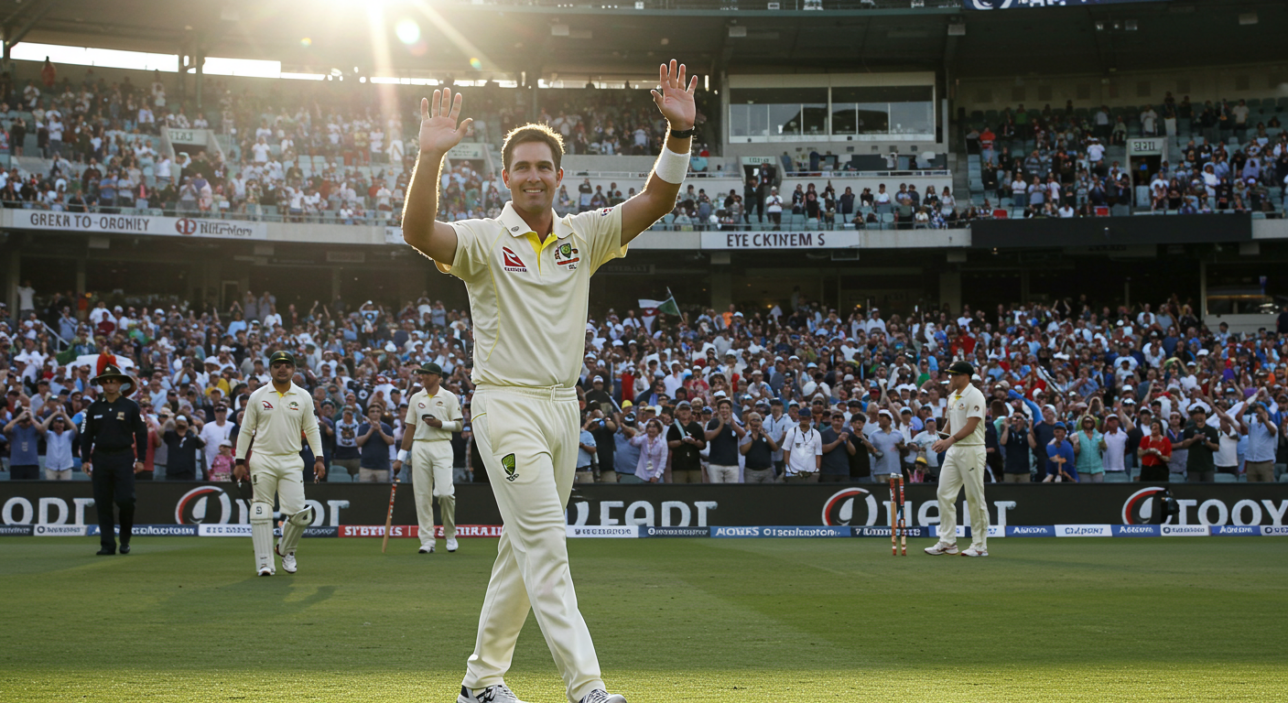
Most fast bowlers fade out. Injuries mount. Pace wanes. They cling to roles they once owned. McGrath, ever the minimalist, exited the game with clarity, timing, and finality.
His last match came in the 2007 World Cup final in Barbados. Australia were dominant. He took another wicket. Then another. He finished with 26 wickets in the tournament—the most by any bowler that year—and led his team to yet another title. There was no grand farewell speech. Just one final spell of relentless control, and a walk off the field with his boots in hand.
The crowd stood. Not just Australians. Everyone. Because even opposition fans knew they had witnessed a once-in-a-generation bowler. Not because he was the fastest. Not because he was the most dramatic. But because he made cricket’s most basic idea—line and length—look like the most complicated art.
He retired not with mystery, but with mastery. His final act was the same as his first: hit the seam, ask the question, walk away when the answer came.
In an era of hype, Glenn McGrath gave us something rare: predictable brilliance. And when he left, cricket didn’t just lose a fast bowler—it lost its most reliable rhythm.
Legacy Etched in the Seam
There are bowlers who entertain, and there are bowlers who dominate. Glenn McGrath did both, but in a way that didn’t rely on spectacle. His legacy isn’t defined by viral clips or outrageous moments—it’s defined by a standard. A blueprint. A quiet authority that modern bowlers still chase but rarely reach.
He wasn’t a showman. He didn’t need exaggerated celebrations or headline quotes. But if you ask the best batters of the 90s and early 2000s—Tendulkar, Lara, Dravid, Kallis—who their hardest opponent was, McGrath’s name comes up with reverence. Not fear. Not frustration. Respect.
And in coaching clinics today, young fast bowlers don’t watch McGrath to be inspired. They watch him to learn. Every generation has a wild card. McGrath was the ruler they measure against. His bowling was a masterclass in control—teaching that rhythm, patience, and execution beat raw aggression more often than not.
He didn’t chase glamour, but he left with grace. He didn’t swing the ball miles, but he made it move just enough. He didn’t reinvent the game, but he refined it to its essence—and then ruled from there.
Glenn McGrath: The Bowler Who Made Repetition Beautiful

Cricket is a game of variety. But within that variety lies the extraordinary appeal of repetition done perfectly. And no one in the modern era did that better than Glenn McGrath.
He wasn’t the fastest. He wasn’t the flashiest. He didn’t change the shape of the game with new deliveries or mysterious actions. What he did was more difficult—he mastered the most basic skill in cricket to a level no one else could match. Line. Length. Seam. Discipline. Over and over again. Without boredom. Without ego.
In a team filled with heat and personality, McGrath was the cool centre. The plan you could trust. The bowler who needed no tricks because he was the trick. He didn’t prey on batters’ weaknesses. He created them. He didn’t rely on deception. He relied on certainty—and forced chaos to bend to his order.
His 563 Test wickets and 381 ODI wickets aren’t just numbers. They are affirmations of control in a sport that often resists it. He made averages plummet, plans collapse, and great batters look ordinary—not with magic balls, but with relentless accuracy.
And perhaps that’s what made him so compelling. Because in a game obsessed with flair, McGrath reminded us that beauty can also lie in precision. That greatness can arrive not with noise—but with the same ball, in the same spot, one more time.
He wasn’t just the metronome of Australian cricket.
He was the tempo every great team since has tried to follow.
